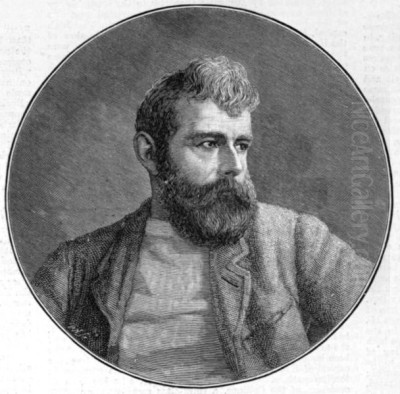
William Lionel Wyllie stands as one of Britain's most celebrated and prolific maritime artists. Spanning a career from the high Victorian era well into the 20th century, Wyllie captured the changing face of Britain's relationship with the sea, from the age of sail to the dawn of the dreadnought, with unparalleled skill and atmospheric sensitivity. Born in London on July 5, 1851, and passing away in the same city on April 6, 1931, Wyllie dedicated his life to depicting the waterways, coastlines, and naval power that were so central to the identity and economy of the British Empire. His mastery extended across oil painting, watercolour, and etching, making him a versatile and highly sought-after artist whose works remain admired for their accuracy, beauty, and historical significance.
Early Life and Artistic Formation
Wyllie's immersion in the art world began at birth. He was born into an artistic family; his father, William Morrison Wyllie (1820–1895), was a successful painter of genre scenes and landscapes, and his mother, Katherine Benham, was a singer. His younger half-brother, Charles William Wyllie (1853–1923), also became a notable marine painter, ensuring that art was a constant presence during his formative years. This environment undoubtedly nurtured his innate talent, which became evident early on.
His formal art education commenced at Heatherley's School of Fine Art in London, a preparatory school known for its less rigid approach compared to the Royal Academy. In 1865, at the young age of 14, Wyllie enrolled in the prestigious Royal Academy Schools. This institution provided rigorous training in drawing, anatomy, and composition, laying the technical foundation for his future career.
Wyllie quickly distinguished himself. During his time at the RA Schools, from 1866 to 1869, his dedication and skill were recognized. The culmination of his studies came in 1869 when, at just 18 years old, he won the coveted Turner Gold Medal for landscape painting. The winning work, reportedly titled Dawn After a Storm, signaled his early promise and inclination towards capturing the dramatic effects of light and weather on water, themes that would dominate his life's work.
Influences and the Development of a Style
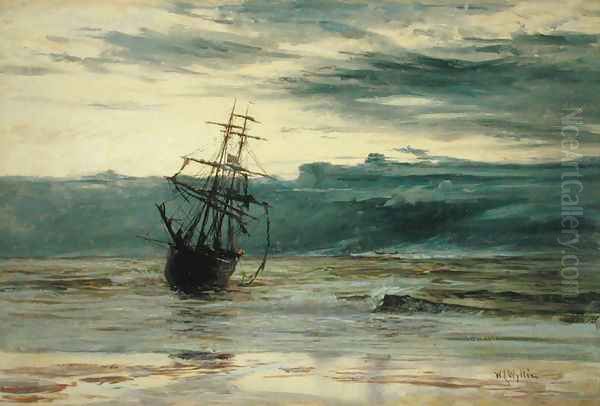
While the Royal Academy provided technical grounding, Wyllie's artistic style evolved through observation and the absorption of various influences. He was profoundly inspired by the great British master of light and sea, J.M.W. Turner (1775-1851). Turner's dramatic seascapes, his focus on atmospheric effects, and his ability to convey the power and majesty of nature left an indelible mark on Wyllie, particularly in his handling of light, sky, and water.
Another significant influence was the American expatriate artist James McNeill Whistler (1834-1903). Whistler's tonalism, his emphasis on subtle harmonies of colour, and his innovative compositions, particularly his 'Nocturnes' of the Thames, likely encouraged Wyllie to explore the atmospheric possibilities of London's river, especially in different light conditions and weather. Whistler was also a master etcher, and his influence can be seen in Wyllie's own dedication to and mastery of printmaking.
Wyllie also looked towards contemporary marine painters. He admired the work of Henry Moore (1831-1895), a prominent British marine painter (distinct from the later sculptor of the same name) known for his realistic and knowledgeable depictions of the sea. Moore's emphasis on accurate observation of wave forms and maritime detail resonated with Wyllie's own commitment to realism.
Beyond artistic influences, Wyllie possessed an insatiable curiosity about his subject matter. He meticulously studied the history and construction of ships, from fishing boats and barges to warships and ocean liners. This deep understanding allowed him to depict vessels with technical accuracy, lending authenticity to his scenes whether they depicted contemporary life or historical events. His style became a unique blend: the romantic drama inherited from Turner, the atmospheric subtlety perhaps informed by Whistler, and a bedrock of detailed realism born from careful observation and technical knowledge.
The Pulse of the Thames
The River Thames, particularly the bustling Pool of London, became one of Wyllie's most enduring and iconic subjects. He was fascinated by the river's constant activity, its role as the commercial artery of the Empire, and its ever-changing moods. He painted it in all conditions – misty mornings, smog-filled afternoons, sunlit evenings, and stormy weather – capturing the unique atmosphere of the industrial waterway.
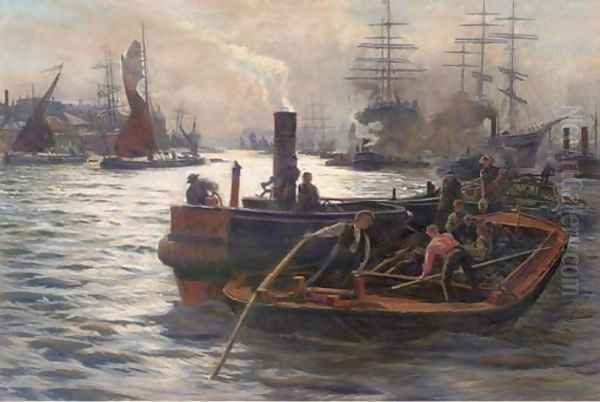
His most famous work, Toil, Glitter, Grime, and Wealth on a Flowing Tide, first exhibited in 1883, perfectly encapsulates his vision of the Thames. Now housed in the Tate Britain, this large oil painting presents a panoramic view of the Pool of London teeming with life. Barges laden with goods jostle for space, tugboats belch smoke, sailing ships navigate the crowded waters, and the background hints at the docks and warehouses lining the riverbanks. The title itself reflects the complex reality Wyllie depicted: the hard labour ('Toil'), the play of light on water ('Glitter'), the industrial pollution ('Grime'), and the commercial prosperity ('Wealth').
Toil, Glitter, Grime, and Wealth was a critical success and cemented Wyllie's reputation. It demonstrated his ability to handle complex compositions, manage a multitude of details without losing overall coherence, and capture the specific light and atmosphere of the London river. It was a scene far removed from the idealized pastoral landscapes often favoured by earlier generations, presenting instead a dynamic, sometimes gritty, but always compelling vision of modern maritime commerce.
Wyllie returned to the Thames throughout his career, producing countless paintings, watercolours, and etchings of its various stretches, from the upper reaches down to the estuary. He painted the Houses of Parliament, Tower Bridge under construction and completed, the docks at Tilbury, and the naval shipyards at Chatham on the Medway, a major tributary. His work provides an invaluable visual record of the river during a period of immense change. Another early notable work exhibited at the Royal Academy in 1870 was London from the Monument, showcasing his interest in panoramic city views incorporating the river.
Versatility Across Media: Oil, Watercolour, and Etching
A hallmark of Wyllie's career was his proficiency across different artistic media, each suited to capturing different aspects of his maritime subjects.
Oil Painting: Wyllie's oils, like Toil, Glitter, Grime, and Wealth, often tackled large-scale, complex scenes. He used oil paint to build up rich textures and capture the dramatic interplay of light and shadow on water and smoke. His brushwork could range from detailed rendering of ships and rigging to broader, more atmospheric handling of skies and water, demonstrating a flexibility that served his varied subjects well. While distinct in subject, his attention to light effects invites comparison with landscape masters like John Constable (1776-1837) or even the French Impressionists like Claude Monet (1840-1926), who also explored the transient effects of light on water, albeit with a different stylistic approach.
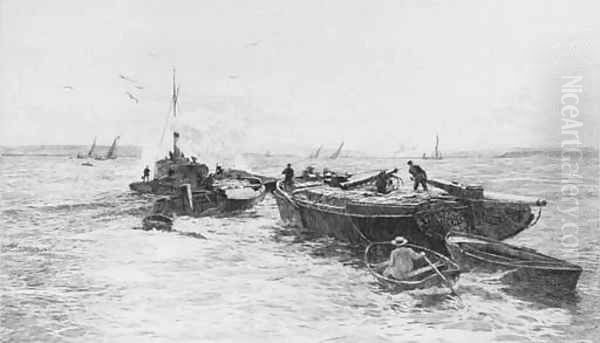
Watercolour: Wyllie was an accomplished watercolourist, elected a member of the Royal Institute of Painters in Water Colours (RI) and later the prestigious Royal Watercolour Society (RWS). His watercolours often possess a luminosity and transparency well-suited to capturing the fleeting effects of weather and light on the sea. He frequently worked on absorbent paper, sometimes with touches of bodycolour (gouache) for highlights or denser areas. These works could be rapid sketches made on location or more finished exhibition pieces. His skill in this medium places him in the strong British tradition of watercolour painting, following masters like Turner and Thomas Girtin (1775-1802). Works like Rochester or A View of a Castle or Château Beside Water showcase his ability to combine topographical accuracy with atmospheric charm in watercolour.
Etching: Wyllie became one of the leading figures of the British Etching Revival. He was a master of the technique, particularly drypoint, where the image is scratched directly onto the copper plate with a sharp needle. This process creates a 'burr' – a raised ridge of metal alongside the incised line – which holds extra ink, resulting in the rich, velvety lines characteristic of many of his prints. He produced hundreds of etchings throughout his career, depicting a vast range of maritime subjects: busy harbours, solitary fishing boats, majestic warships, and historical naval battles.
His etchings were highly popular and commercially successful, published by galleries like Robert Dunthorne's Rembrandt Gallery. They demonstrate his superb draughtsmanship, his ability to suggest light and atmosphere through line alone, and his deep knowledge of maritime life. His work in this medium rivals that of his contemporary etchers like Sir Frank Short (1857-1945) and Mortimer Menpes (1855-1938), and stands comparison with the expressive line work of Whistler. While their subjects differed greatly, the technical mastery of etching connects Wyllie to the historical giant of the medium, Rembrandt (1606-1669). Examples like Fishermen and Shipping or Rowing Boats Beside a Mountainous Landscape show his typical skill in composition and line.
Chronicler of the Sea and Navy
While the Thames was a central focus, Wyllie's artistic gaze extended far beyond London's river. He was captivated by all aspects of maritime life and naval power. He frequently painted scenes along the English Channel coast, particularly the Solent, the strait separating the Isle of Wight from the mainland, which was a major naval anchorage and yachting centre. Portsmouth, with its historic dockyard and naval base, was a favourite location.
His expertise and passion led to official recognition. He was appointed Marine Painter to the Royal Yacht Squadron and the Royal Victoria Yacht Club, prestigious titles reflecting his standing within the maritime community. He also undertook commissions for major shipping lines, including the Orient Company, White Star Line, and Union Castle Line, creating posters and illustrations that promoted sea travel during its golden age.
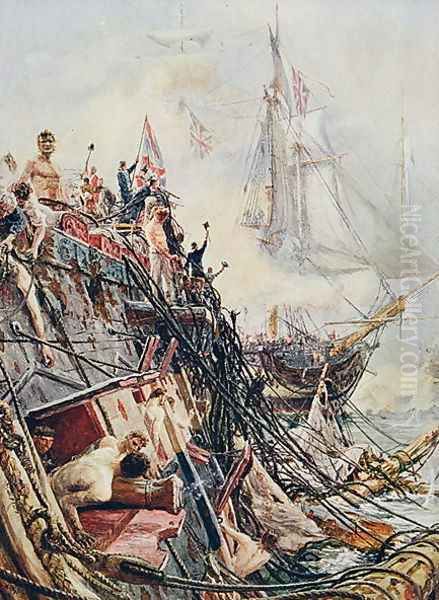
Wyllie had a deep and abiding interest in the Royal Navy, both its history and its contemporary state. He meticulously researched and depicted historical naval battles, most notably the Battle of Trafalgar. His large panoramic painting of the battle, created in the 1920s, and the associated detailed etchings, are considered significant historical works and are housed in the Royal Naval Museum in Portsmouth. These works demonstrate his commitment to accuracy in depicting the ships, formations, and action of Nelson's famous victory.
During the First World War (1914-1918), Wyllie turned his attention to documenting the naval conflict. Although too old for active service, he observed naval activities extensively, particularly around the Dover Patrol and Harwich Force. He produced numerous paintings and drawings of warships, submarines, coastal motor boats, and naval actions. Works like the watercolour Motor Launch 'ML141' (1915) depict the new technologies of naval warfare. He created images commemorating naval sacrifice and victory, such as the etchings Signal for Victory at Portsmouth Harbour and The Last Resting Place for Victory. His contributions provide a valuable artistic record of the war at sea, comparable in documentary intent, if not always style, to the work of official war artists like Paul Nash (1889-1946) or C.R.W. Nevinson (1889-1946). His connection to the navy was personal; he spent considerable time painting aboard Nelson's flagship, HMS Victory, during its restoration in Portsmouth.
Signature Works and Exhibitions
Beyond the seminal Toil, Glitter, Grime, and Wealth, several other works stand out in Wyllie's extensive oeuvre:
The Battle of Trafalgar (Painting and Etchings, c. 1920s): A monumental undertaking depicting the climax of Nelson's victory, praised for its historical detail and dramatic composition.
London from the Monument (Exhibited RA 1870): An early success showing his ambition in tackling complex cityscapes dominated by the river.
A View from an Air Balloon (Wood engraving, early career): An unusual perspective demonstrating his interest in different viewpoints, capturing the docks and city centre.
Rochester (Watercolour): Depicting the Medway town with its castle and cathedral, blending picturesque elements with signs of industry and maritime activity.
King George V's River Pageant (1919): Documenting the post-WWI peace celebrations on the Thames, showcasing his ability to capture contemporary events.
The Pool of London (Numerous versions, various media): Wyllie returned repeatedly to this subject, capturing its changing light and ceaseless activity.

Wyllie was a regular exhibitor at the Royal Academy from 1868 onwards. He also showed frequently at the Royal Watercolour Society, the Royal Institute of Painters in Water Colours, the Fine Art Society, Dowdeswell's Galleries, the Rembrandt Gallery (primarily etchings), and other venues in London and provincial cities. His work was widely collected during his lifetime and continues to be sought after by institutions and private collectors.
Professional Standing and Recognition
Wyllie's talent and hard work brought him considerable professional recognition. He was elected an Associate of the Royal Academy (ARA) in 1889 and achieved the distinction of full Royal Academician (RA) in 1907 (some sources state 1909, but 1907 is more commonly cited for RA election). Membership in the RA was the pinnacle of artistic achievement in Britain at the time.
His memberships in the Royal Watercolour Society (RWS) and the Royal Institute of Painters in Water Colours (RI) further attested to his skill in that medium. He was also involved in the founding or early support of societies dedicated to marine art, contributing to the establishment of a distinct field for maritime painters. His work as an illustrator for the influential journal The Graphic brought his images to a wider public.
His reputation was built on his technical skill, his profound knowledge of his subject, his ability to convey atmosphere, and his sheer productivity. He was seen as the heir to the great tradition of British marine painting, adapting it to the realities of the modern industrial and naval age.
Life Beyond the Studio: The 'Ladybird' and Family
Wyllie's commitment to authenticity extended to his working methods. For many years, he owned a yacht, initially a 40-foot yawl named Ladybird, and later other vessels. This yacht served as a floating studio, allowing him to observe his subjects directly and sketch or paint en plein air on the water. He sailed extensively along the Thames, the English Channel coast, and across to France and Holland, constantly gathering material. His time spent living in Hoo, Kent, on the Medway estuary, and later in Portsmouth, overlooking the harbour entrance from Tower House, further immersed him in the maritime world.
His personal life included time spent in Northern France during his childhood, and he returned to paint the French coast, particularly around Boulogne and Wimereux, where his family had connections. He married Marion Amy Carew (1855-1935) in 1879, and they had nine children. His home life, particularly at Tower House in Portsmouth from 1906 until his death, was closely intertwined with his artistic practice, offering panoramic views of the shipping activity in the Solent and Spithead.
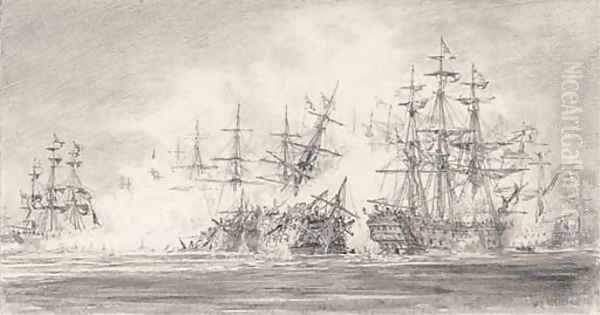
His relationship with his brother, Charles William Wyllie, was significant. Both were talented marine painters, and they shared studios at times and likely influenced each other. They were both involved in movements advocating for reforms within the Royal Academy. However, William's greater fame and prolific output tended to overshadow Charles's considerable talents, a common occurrence in artistic families.
Wyllie in Context: Contemporaries and the Art World
Placing William Lionel Wyllie within the broader art world of the late 19th and early 20th centuries helps to appreciate his unique contribution. He worked during a period of significant artistic change, bridging the gap between Victorian realism and the stirrings of modernism.
In marine painting, his contemporaries included Charles Napier Hemy (1841-1917), known for his vigorous depictions of coastal scenes and fishing boats, often painted from his own floating studio, and Thomas Somerscales (1842-1927), famed for his dramatic paintings of sailing ships battling heavy seas, particularly off the coast of South America. While Wyllie shared their dedication to maritime subjects, his range, encompassing industrial riverscapes, naval history, and atmospheric etchings, was arguably broader.
His connection to Whistler links him to the Aesthetic Movement and the Etching Revival. Other artists associated with Whistler and the Thames included Walter Greaves (1846-1930), who painted the river with intimate knowledge but less technical polish than Wyllie. The Etching Revival saw numerous skilled practitioners like Sir Frank Short and Mortimer Menpes, with whom Wyllie shared a commitment to exploring the expressive potential of line.
While not an Impressionist, Wyllie's sensitivity to light and atmosphere runs parallel to the concerns of artists like Monet, who famously painted the Thames during his visits to London, capturing its fogs and changing light, albeit with a focus on colour and broken brushwork that differed significantly from Wyllie's more structured approach. Wyllie remained essentially a realist, grounded in the observational traditions of British art exemplified by figures like Constable, but applied to the dynamic world of maritime Britain. His father, William Morris Wyllie, represented the earlier generation of Victorian genre and landscape painters from which he emerged.
Enduring Legacy
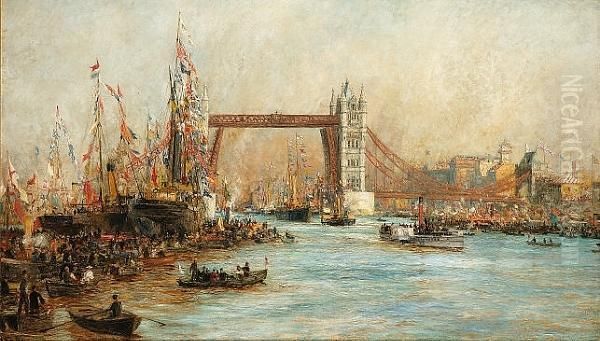
William Lionel Wyllie left behind an immense body of work that serves as both fine art and historical document. His paintings, watercolours, and etchings provide an unparalleled visual record of British maritime life, commerce, and naval power during a crucial period of transition. He captured the end of the age of sail, the rise of steam power, the might of the Royal Navy in the era leading up to and including the First World War, and the bustling energy of the River Thames as the heart of a global empire.
His technical mastery, particularly in etching and watercolour, remains admired. His ability to combine detailed accuracy with profound atmospheric sensitivity gives his work an enduring appeal. He successfully navigated the demands of the art market while remaining true to his chosen subject matter, earning both critical acclaim and popular success.
Today, his works are held in major public collections across the United Kingdom and beyond, including Tate Britain, the National Maritime Museum in Greenwich, the Imperial War Museum, the Royal Academy of Arts, the Royal Naval Museum in Portsmouth, and numerous regional galleries. William Lionel Wyllie's legacy is that of a dedicated and supremely skilled artist who chronicled the maritime world he knew so intimately, leaving behind a rich and evocative portrait of Britain's age-old relationship with the sea. He remains a pivotal figure in British marine art.